Publication 102 - Wisconsin Tax Treatment Of Tax-Option (S) Corporations And Their Shareholders Page 19
ADVERTISEMENT
Wisconsin Tax Treatment of Tax-Option (S) Corporations and Their Shareholders
the federal and Wisconsin treatment of corporate distri-
The shareholders, who are Wisconsin residents, also file Wis-
consin returns on a calendar-year basis. The shareholders’
butions. See Part X.
federal stock bases were increased by $5,000, their shares of
the 1978 income, and decreased by the $3,000 distributions of
4. Gain or Loss on Disposition of Capital Stock
1978 income. Their Wisconsin stock bases were not affected
by the 1978 income and cash distributions.
When a Wisconsin resident shareholder disposes of
capital stock in a tax-option (S) corporation in a taxable
The corporation’s Wisconsin net income equaled its federal net
transaction, the shareholder must include the gain or loss
income for each of the years 1979 through 1996, and the entire
on such disposition in Wisconsin adjusted gross income
amount of income was distributed to the shareholders each
for the taxable year in which the stock is sold, ex-
year. Thus for both federal and Wisconsin purposes, the
changed, or becomes worthless. Since gain or loss on
increases in the shareholders’ stock bases for their shares of the
such disposition follows the residence of the sharehold-
corporation’s net income were offset by the decreases for the
cash distributions.
er, a nonresident shareholder doesn’t include the gain or
loss in his or her Wisconsin adjusted gross income.
On September 1, 1997, Shareholder A sells all of his stock for
$20,000. For 1997, the corporation has $15,000 of income.
If a resident shareholder’s Wisconsin basis of the stock
Assuming no section 1377(a)(2) election is made for the year
is the same as the federal basis, the Wisconsin gain or
of disposition, Shareholder A’s share of the 1997 income is
loss on disposition will be identical to the federal
$4,993 (50% x 243/365 x $15,000), which increases his stock
amount. If the Wisconsin and federal bases differ, a
basis by $4,993. Shareholder A computes his federal and
modification must be made to federal adjusted gross
Wisconsin gain on the sale as follows:
income for the difference.
Federal
Wisconsin
A difference in basis may exist at the end of the corpora-
Selling price
$ 20,000
$ 20,000
tion’s 1978 taxable year if the corporation had reported
Basis on September 1,
under Subchapter S for federal tax purposes before the
1997
13,993
11,993
1979 taxable year, the first year to which the Wisconsin
Gain on disposition
$
6,007
$
8,007
tax-option (S) law applied. A Subchapter S corporation’s
pre-1979 federal undistributed taxable income, nontax-
Example 2: Assume the same facts as in Example 1, except
able distributions, and tax losses affect a shareholder’s
that the corporation had a $10,000 federal tax loss for its 1978
federal basis of the corporation’s stock but not the
taxable year and didn’t distribute $6,000 on March 15, 1979.
Wisconsin basis.
The shareholders each deducted $5,000 of the loss on their
1978 federal returns.
Beginning with the 1979 taxable year, a Wisconsin
If Shareholder A sells his stock for $20,000 on September 1,
resident shareholder’s Wisconsin basis of a tax-option
1997, his federal gain is $13,007 ($20,000 minus $6,993 ba-
(S) corporation’s capital stock is affected by 1979 and
sis); whereas his Wisconsin gain is still $8,007 ($20,000 minus
later years’ Wisconsin corporate income and losses
$11,993 basis).
passed through and taxed to or deducted by shareholders
for Wisconsin tax purposes. See Part XI for a description
However, if the stock is sold for $5,000 on September 1, 1997,
of how the Wisconsin basis of a shareholder’s capital
a federal loss of $1,993 results ($5,000 minus $6,993 basis),
stock is computed.
and the Wisconsin loss is $6,993 ($5,000 minus $11,993
basis).
Examples of the federal and Wisconsin gain or loss on
the disposition of capital stock by shareholders of
D. Corporate Losses Deductible by Shareholders
corporations which elected Subchapter S treatment for
taxable years before 1979 follow.
A tax-option (S) corporation’s losses for a year are passed
through to all shareholders in the same manner as income
Example 1: A corporation was incorporated on January 1,
during the year if the corporation is engaged in activities for
1978. The corporation’s two shareholders each invested
the purpose of making a profit. Each person who is a share-
$7,000 in exchange for equal shares of its capital stock. The
holder at any time during the corporation’s taxable year may
corporation elected to be taxed under federal Subchapter S
deduct a pro rata share of such losses. However, the amount
beginning with its 1978 calendar year. Its 1978 federal taxable
of loss that may be deducted each year is subject to certain
income was $10,000, of which $6,000 was distributed to its
limits.
shareholders in cash on March 15, 1979. No further distribu-
tions of 1978 income were made.
17
ADVERTISEMENT
0 votes
Related Articles
Related forms
Related Categories
Parent category: Financial
 1
1 2
2 3
3 4
4 5
5 6
6 7
7 8
8 9
9 10
10 11
11 12
12 13
13 14
14 15
15 16
16 17
17 18
18 19
19 20
20 21
21 22
22 23
23 24
24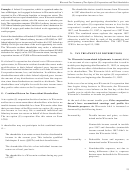 25
25 26
26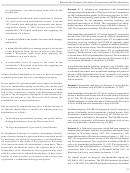 27
27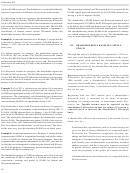 28
28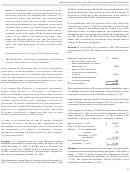 29
29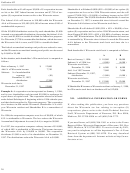 30
30








